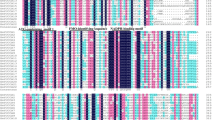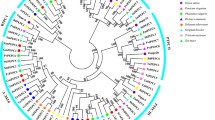Abstract
Genes encoding glycine- and proline-rich proteins (GPRPs) are widely distributed in land plants, but these have been rarely characterised. In this study, a total of six GPRPs (GmGPRP1 to 6) have been identified in the soybean genome database, and full-length complementary DNA and genomic DNA sequences of GmGPRP3 and GmGPRP4 have been cloned. GmGPRP1-6 genes encoded a set of small predicted proteins (<185aa) with molecular mass of 12.35–19.67 kDa and isoelectric point of 6.79–10.22. GmGPRP1-5 contained three exons and two introns with fixed occurring sites, whereas GmGPRP6 only has two exons and one intron. In the deduced GmGPRP1-5 sequences, six amino acids (glycine, proline, histidine, alanine, lysine and tyrosine) account for more than 75% of the total protein composition. GmGPRPs showed high similarity to other known GPRPs at amino acid level. Most of GPRPs had three conserved regions, including an N-terminal XYPP-repeat domain, a central hydrophobic domain containing several uninterrupted alanine residues and a C-terminal HGK-repeat region. The transcripts of GmGPRP1, 3 and 4 appeared in different organs including seedling leaves, stems and roots, flowers and developing seeds, but every gene showed a unique organ-specific expression pattern. Furthermore, the expression of GmGPRP1, 3 and 4 was significantly induced by drought, salt and cold, but repressed by abscisic acid. In silico analysis of promoter regions of these genes revealed the presence of putative abiotic-stress regulatory elements. Our data suggest GmGPRPs encoding a class of conservative XYPP-repeat proteins probably play an important role in plant development as well as in response to abiotic stresses.





Similar content being viewed by others
Abbreviations
- DAF:
-
Days after flowering
- GPRP:
-
Glycine- and proline-rich protein
- PGYRP:
-
Proline-, glycine- and tyrosine-rich protein
- UTR:
-
Untranslated region
References
Bae H, Kim MS, Sicher RC, Bae HJ, Bailey BA (2006) Necrosis-and ethylene-inducing peptide from Fusarium oxysporum induces a complex cascade of transcripts associated with signal transduction and cell death in Arabidopsis. Plant Physiol 141:1056–1067
Balakrishnan S, Kumpatla S, Viawanathan V (2010) Comparative analysis of transcription factors of insulin signaling (Insulin receptor substrate family). India J Biotech 9:24–30
Bergmann DC, Lukowitz W, Somerville CR (2004) Stomatal development and pattern controlled by a MAPKK kinase. Science 304:1494–1497
Blank M, Shoenfeld Y (2008) Histidine-rich glycoprotein modulation of immune/autoimmune, vascular, and coagulation systems. Clinic Rev Allerg Immunol 34:307–312
Bocca SN, Magioli C, Mangeon A, Junqueira RM, Cardeal V, Margis R et al (2005) Survey of glycine-rich proteins (GRPs) in the Eucalyptus expressed sequence tag database (ForEST). Genet Mol Biol 28:608–624
Boter M, Ruiz-Rivero O, Abdeen A, Prat S (2004) Conserved MYC transcription factors play a key role in jasmonate signaling both in tomato and Arabidopsis. Genes Dev 18:1577–1591
Brownawell AM, Creutz CE (1997) Calcium-dependent binding of sorcin to the N-terminal domain of synexin (Annexin VII). J Biol Chem 272:22182–22190
Chang WC, Lee TY, Huang HD, Huang HY, Pan RL (2008) PlantPAN: Plant Promoter Analysis Navigator, for identifying combinatorial cis-regulatory elements with distance constraint in plant gene group. BMC Genomics 9:561
Chew YH, Halliday KJ (2011) A stress-free walk from Arabidopsis to crops. Curr Opin Biotechnol 22:281–286
Corrina RH, Helen CB, Martin RB, John PH, Andrew M, Katharine AP, Jeremy P, Philip JW (2004) Cesium toxicity in Arabidopsis. Plant Physiol 136:3824–3837
Diaz-De-Leon F, Klotz KL, Lagrimini M (1993) Nucleotide sequence of the tobacco (Nicotiana tabacum) anionic peroxidase gene. Plant Physiol 101:1117–1118
Dinneny JR, Long TA, Wang JY, Jung JW, Mace D, Pointer S, Barron C, Brady SM, Schiefelbein J, Benfey PN (2008) Cell identity mediates the response of Arabidopsis roots to abiotic stress. Science 320:942–945
Falvo S, Acquadro A, Albo AG, America T, Lanteri S (2011) Proteomic analysis of PEG-fractionated UV-C stress-response proteins in Globe artichoke. Plant Mol Bio Rep. doi:10.1007/s11105-011-0325-2
Feng Y, Peng H, Liang S (2011) Molecular analysis of the PGYRP (proline-, glycine-and tyrosine-rich protein) gene family in soybean. Mol Biol Rep 38:2739–2750
Gerke V, Moss SE (2002) Annexins: from structure to function. Physiol Rev 82:331–371
Guan Y, Nothnagel EA (2004) Binding of arabinogalactan proteins by Yariv Phenylglycoside triggers wound-like responses in Arabidopsis cell cultures. Plant Physiol 135:1346–1366
Hofmann K, Stoffel W (1993) TMbase—a database of membrane spanning proteins segments. Biol Chem Hoppe Seyler 374:166
Hubbard KE, Nishimura N, Hitomi K, Getzoff ED, Schroeder JI (2010) Early abscisic acid signal transduction mechanisms: newly discovered components and newly emerging questions. Gene Dev 24:1695–1708
Ingram J, Bartels D (1996) The molecular basis of dehydration tolerance in plants. Annu Rev Plant Physiol Plant Mol Biol 47:377–403
Kelley LA, Sternberg MJE (2009) Protein structure prediction on the web: a case study using the Phyre server. Nat Protoc 4:363–371
Lee BH, Henderson DA, Zhu JK (2005) The Arabidopsis cold-responsive transcriptome and its regulation by ICE1. Plant Cell 17:3155–3175
Lescot M, Déhais P, Thijs G, Marchal K, Moreau Y, Van de PY, Rouzé P, Rombauts S (2002) PlantCARE, a database of plant cis-acting regulatory elements and a portal to tools for in silico analysis of promoter sequences. Nucleic Acids Res 30:325–327
Li H, Yang J, Wang YY, Chen ZJ, Tu SS, Feng LL, Zhu YG, Li YS (2009) Expression of a novel OsPGYRP (rice proline-, glycine-and tyrosine-rich protein) gene, which is involved in vesicle trafficking, enhanced cold tolerance in E. coli. Biotechnol Lett 31:905–910
Li F, Lei HJ, Zhao XJ, Tian RR, Li TH (2011a) Characterization of three sorbitol transporter genes in micropropagated apple plants grown under drought stress. Plant Mol Bio Rep. doi:10.1007/s11105-011-0323-4
Li YM, Zhu L, Xu BC, Yang JH, Zhang MF (2011b) Identification of down-regulated genes modulated by an alternative oxidase pathway under cold stress conditions in watermelon plants. Plant Mol Bio Rep. doi:10.1007/s11105-011-0333-2
Lister R, Chew O, Lee MN, Heazlewood JL, Clifton R, Parker KL, Millar AH, Whelan J (2004) A transcriptomic and proteomic characterization of the Arabidopsis mitochondrial protein import apparatus and its response to mitochondrial dysfunction. Plant Physiol 134:777–789
Ma L, Gao Y, Qu L, Chen Z, Li J, Zhao H, Deng XW (2002) Genomic evidence for COP1 as a repressor of light-regulated gene expression and development in Arabidopsis. Plant Cell 14:2383–2398
Marty I, Monfort A, Stiefel V, Ludevid D, Delseny M, Puigdomènech P (1996) Molecular characterization of the gene coding for GPRP, a class of proteins rich in glycine and proline interacting with membranes in Arabidopsis thaliana. Plant Mol Biol 30:625–636
Matsushima N, Creutz CE, Kretsinger RH (1990) Novel secondary structures proposed for the tandem repeats within rhodopsin, synaptophysin, synexin, gliadin, RNA polymerase II, hordein, and gluten. Proteins 7:125–155
Nakahara KS, Kitazawa H, Atsumi G, Choi SH, Suzuki Y, Uyeda I (2011) Screening and analysis of genes expressed upon infection of broad bean with Clover yellow vein virus causing lethal necrosis. Virol J. doi:10.1186/1743-422X-8-355
Palm CJ, Costa MA, An G, Ryan CA (1990) Wound-inducible nuclear protein binds DNA fragments that regulate a proteinase inhibitor II gene from potato. Proc Natl Acad Sci USA 87:603–607
Park HC, Kim ML, Kang YH, Jeon JM, Yoo JH, Kim MC et al (2004) Pathogen- and NaCl-induced expression of the SCaM-4 promoter is mediated in part by a GT-1 box that interacts with a GT-1-like transcription factor. Plant Physiol 135:2150–2161
Pastuglia M, Roby D, Dumas C, Cock JM (1997) Rapid induction by wounding and bacterial infection of an S gene family receptor-like kinase in Brassica oleracea. Plant Cell 9:1–13
Pfaffl MW (2001) A new mathematical model for relative quantification in real-time RT-PCR. Nucleic Acids Res 29:e45
Pfaffl MW, Horgan GW, Demple L (2002) Relative expression software tool (REST) for group-wise comparison and statisitcal analysis of relative expression results in real-time PCR. Nucleic Acids Res 30:e36
Pommerrenig B, Barth I, Niedermeier M, Kopp S, Schmid J, Dwyer RA (2006) Common Plantain. A collection of expressed sequence tags from vascular tissue and a simple and efficient transformation method. Plant Physiol 142:1427–1441
Rouster J, Leah R, Mundy J, Cameron-Mills V (1997) Identification of a methyl jasmonate-responsive region in the promoter of a lipoxygenase 1 gene expressed in barley grain. Plant J 11:513–523
Rushton PJ, Torres JT, Parniske M, Wernert P, Hahlbrock K, Somssich IE (1996) Interaction of elicitor-induced DNA-binding proteins with elicitor response elements in the promoters of parsley PR1 genes. EMBO J 15:5690–5700
Sachetto-Martins G, Franco LO, de Oliveira DE (2000) Plant glycine-rich proteins: a family or just proteins with a common motif? Bioch Biophys Acta 1492:1–14
Saitou N, Nei M (1987) The neighbor-joining method: a new method for reconstructing phylogenetic trees. Mol Biol Evol 13:964–969
Seki M, Umezawa T, Urano K, Shinozaki K (2007) Regulatory metabolic networks in drought stress responses. Curr Opin Plant Biol 10:296–302
Sibout R, Eudes A, Mouille G, Pollet B, Lapierre C, Jouanin L, Séguin A (2005) Cinnamyl alcohol dehydrogenase-C and -D are the primary genes involved in lignin biosynthesis in the floral stem of Arabidopsis. Plant Cell 17:2059–2076
Süldhof TC, Lottspeich F, Greengard P, Mehl E, Jahn R (1987) A synaptic vesicle protein with a novel cytoplasmic domain and four transmembrane regions. Science 238:1142–1144
Sutoh K, Yamauchi D (2003) Two cis-acting elements necessary and sufficient for gibberellin-upregulated proteinase expression in rice seeds. Plant J 34:636–645
Suzuki M, Ketterling MG, McCarty DR (2005) Quantitative statistical analysis of cis-regulatory sequences in ABA/VP1- and CBF/DREB1-regulated genes of Arabidopsis. Plant Physiol 139:437–447
Thompson JD, Gibson TJ, Plewniak F, Jeanmougin F, Higgins DG (1997) The CLUSTAL X windows interface: flexible strategies for multiple sequence alignment aided by quality analysis tools. Nucleic Acids Res 25:4876–4882
Tjaden G, Edwards JW, Coruzzi GM (1995) cis elements and trans-acting factors affecting regulation of a nonphotosynthetic light-regulated gene for chloroplast glutamine synthetase. Plant Physiol 108:1109–1117
Ulmasov T, Hagen G, Guilfoyle TJ (1999) Dimerization and DNA binding of auxin response factors. Plant J 19:309–319
Umezawa T, Sakurai T, Totoki Y, Toyoda A, Seki M, Ishiwata A et al (2008) Sequencing and analysis of approximately 40,000 soybean cDNA clones from a full-length-enriched cDNA library. DNA Res 15:333–346
Verzili D, Zamparelli C, Mattei B, Noegel AA, Chiancone E (2000) The sorcin-annexin VII calcium-dependent interaction requires the sorcin N-terminal domain. FEBS Lett 471:197–200
Xin Z, Zhao Y, Zheng ZL (2005) Transcriptome analysis reveals specific modulation of abscisic acid signaling by ROP10 small GTPase in Arabidopsis. Plant Physiol 139:1350–1365
Xue GP (2002) Characterisation of the DNA-binding profile of barley HvCBF1 using an enzymatic method for rapid, quantitative and high-throughput analysis of the DNA-binding activity. Nucleic Acids Res 30:e77
Yamaguchi-Shinozaki K, Shinozaki K (1993) Arabidopsis DNA encoding two desiccation-responsive rd29 genes. Plant Physiol 101:1119–1120
Yamaguchi-Shinozaki K, Shinozaki K (2005) Organization of cis-acting regulatory elements in osmotic- and cold-stress responsive promoters. Trends Plant Sci 10:88–94
Yamaguchi-Shinozaki K, Shinozaki K (2006) Transcriptional regulatory networks in cellular responses and tolerance to dehydration and cold stresses. Annu Rev Plant Biol 57:781–803
Yamamoto S, Nakano T, Suzuki K, Shinshi H (2004) Elicitor-induced activation of transcription via W box-related cis-acting elements from a basic chitinase gene by WRKY transcription factors in tobacco. Biochim Biophys Acta 1679:279–287
Zhang X, Zhen JB, Li ZH, Kang DM, Yang YM, Kong J, Hua JP (2011) Expression profile of early responsive genes under salt stress in upland cotton (Gossypium hirsutum L.). Plant Mol Bio Rep 29:626–637
Acknowledgements
This work was supported by National Natural Science Foundation of China (31160300), the research funds of Key Laboratory of Ecology of Rare and Endangered Species and Environmental Protection (Guangxi Normal University), Ministry of Education, China (GKN1001Z011) and the foundation of grand science and technology special of Guangxi Beibu Gulf (2010GXNSFE013003).
Author information
Authors and Affiliations
Corresponding author
Additional information
H. Peng and Y. Feng contibuted equally to this work.
Electronic supplementary material
Below is the link to the electronic supplementary material.
Supplementary data 1
(DOC 103 kb)
Supplementary data 2
(TXT 8 kb)
Supplementary data 3
(DOC 35 kb)
Supplementary data 4
(DOC 31 kb)
Rights and permissions
About this article
Cite this article
Peng, H., Feng, Y., Zhang, H. et al. Molecular Cloning and Characterisation of Genes Coding for Glycine- and Proline-Rich Proteins (GPRPs) in Soybean. Plant Mol Biol Rep 30, 566–577 (2012). https://doi.org/10.1007/s11105-011-0363-9
Published:
Issue Date:
DOI: https://doi.org/10.1007/s11105-011-0363-9




